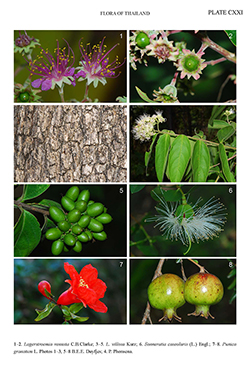e-Flora of Thailand
Volume 11 > Part 4 > Year 2014 > Page 585 > Lythraceae > Punica
Punica granatum L.wfo-0000468843
Sp. Pl. 1: 472. 1753; Gagnep., Fl. Indo-Chine [P.H.Lecomte et al.] 2: 977. 1921; Backer in Fl. Males., Ser. 1, Spermat. 4: 226, f. 1. 1951; Backer in Backer & Bakh.f., Fl. Java 1: 259. 1964; V.C.Vu, Fl. Cambodge, Laos & Vietnam 4: 190. 1965; Smitinand, Thai plant names, revised edition: 441 (including var. nana Pers.). 2001; H.N.Qin & S.A.Graham, Fl. China 13: 283. 2007. Fig. 11; Plate CXXI: 7–8.
Accepted Name : This is currently accepted.
Description : Shrub to 5 m tall, glabrous; branchlets 4-angled, becoming terete with age, often terminating as spines. Leaves: petiole 0.1–0.7 cm long; lamina shiny above, lanceolate, elliptic-oblanceolate, or oblong, 2–9 by 1–2 cm, base attenuate, apex obtuse, mucronate. Flowers: calyx tube orange-red (yellow), campanulate-urceolate, 20–35 by 10–15 mm; calyx lobes (5–)6(–9), long-triangular, 10–12 mm long, erect; petals 5–9, red (or white), obovate, not clawed, 15–30 by (5–)10–20 mm, apex obtuse, caducous; stamens numerous, included or exserted; ovary 8–13-loculed. Fruit a globose leathery berry, red or yellow-green or red-brown, 5–12 cm diam. Seeds horny, obpyramidal within juicy (pale) red sarcotesta.
Distribution : Widespread, introduced, etc from Central Asia, naturalised in western China (lectotype from European Mediterranean area, herb. Clifford 184, BM000628599).
Vernacular : Thap thim (ทับทิม)(Central); phila (พิลา)(Nong Khai); phila khao (พิลาขาว), ma kong kaeo (มะก่องแก้ว)(Nan); ma ko (มะเก๊าะ)(Northern); mak-chang (หมากจัง)(Shan-Mae Hong Son); sia-lio (เซียะลิ้ว)(Chinese).
CommonName : Pomegranate
Uses: Cultivated for its showy flowers, edible fruit (pomegranate), and for medicinal use.


